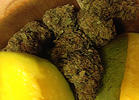
While reaching for a hot cup of coffee in the morning may seem like a no-brainer and guzzling Nyquil or even an alcoholic beverage before bedtime may make sense for one’s sleep routine, sometimes it’s beneficial to seek more natural, non-habit-forming alternatives like cannabis.
Known for decades to possess a treasure trove of applications, medical marijuana is now legal in some form in 47 states (30 have extensive programs covering many conditions and ailments, 17 are limited to CBD products only). Cannabis can also help tackle problems associated with energy and sleep.
The benefits of using cannabis as a morning starter or nightcap depend on what type you use, how and when you use it and your personal history with it. However, in order to understand how marijuana may improve your energy or help you fall asleep, you need to familiarize yourself with the body’s endocannabinoid system (ECS).
The ECS has receptors that cannabinoids, or cannabis chemicals, bind to, which produce anti-inflammatory and pain-relieving effects. These chemicals work within a natural regulatory framework in your body that moderates and manages important processes like mood, appetite, pain and sleep.
Along with THC, CBD and other cannabinoids, the cannabis plant includes terpenoids and flavinoids that provide its tastes and smells. Terpenes work in synergy with cannabinoids to provide the desired effects. While limonene (found in all citrus fruits) has uplifting effects that combat stress, anxiety, depression and fatigue, myrcene, also found in mangoes, is known to induce sleep and reduce pain. Eating a mango before smoking a strain high in myrcene like Special Kush or White Widow is recommended.
Generally, sativas are lighter and energizing and indicas are heavier and sleep inducing.
A Note About Anandamide
Inside the ECS, natural chemicals work to regulate these processes, including anandamide, an endocannabinoid released during physical exertion that causes a euphoric state known as “runner’s high.” When chemical concentrations of anandamide are increased, you receive a boost of energy. Runners find this helps them overcome fatigue and keep going.
If anandamide acts like a power switch, then the fatty acid amide hydrolase (FAAH) turns this switch off. FAAH breaks down concentrations of anandamide in the ECS in a process called hydrolysis. Depending on when, what and how much is ingested, cannabis can either increase anandamide, causing an energy boost, or increase FAAH, creating feelings of sleepiness.
For the perfect pick-me-up, San Diego-based startup Cannabiniers has created a k-cup style coffee pod infused with cannabis. People want options for their energy needs, and thanks to your ECS, cannabis is ready to give them the boost they need.
This article was written by Chris Matich for Nakturnal.






